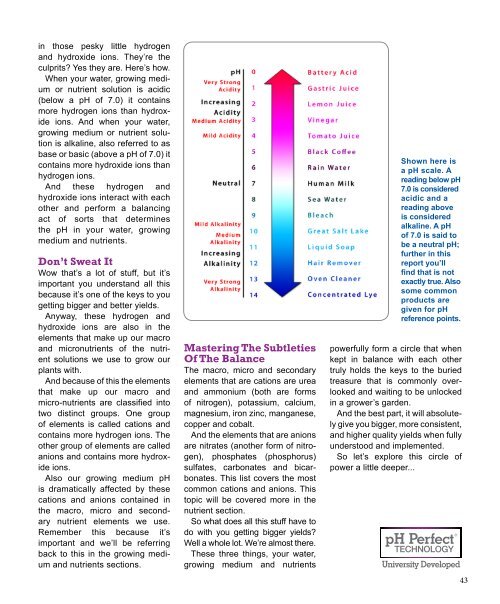Create successful ePaper yourself
Turn your PDF publications into a flip-book with our unique Google optimized e-Paper software.
in those pesky little hydrogen<br />
and hydroxide ions. They’re the<br />
culprits? Yes they are. Here’s how.<br />
When your water, growing medium<br />
or nutrient solution is acidic<br />
(below a pH of 7.0) it contains<br />
more hydrogen ions than hydroxide<br />
ions. And when your water,<br />
growing medium or nutrient solution<br />
is alkaline, also referred to as<br />
base or basic (above a pH of 7.0) it<br />
contains more hydroxide ions than<br />
hydrogen ions.<br />
And these hydrogen and<br />
hydroxide ions interact with each<br />
other and perform a balancing<br />
act of sorts that determines<br />
the pH in your water, growing<br />
medium and nutrients.<br />
Don’t Sweat It<br />
Wow that’s a lot of stuff, but it’s<br />
important you understand all this<br />
because it’s one of the keys to you<br />
getting bigger and better yields.<br />
Anyway, these hydrogen and<br />
hydroxide ions are also in the<br />
elements that make up our macro<br />
and micronutrients of the nutrient<br />
solutions we use to grow our<br />
plants with.<br />
And because of this the elements<br />
that make up our macro and<br />
micro-nutrients are classified into<br />
two distinct groups. One group<br />
of elements is called cations and<br />
contains more hydrogen ions. The<br />
other group of elements are called<br />
anions and contains more hydroxide<br />
ions.<br />
Also our growing medium pH<br />
is dramatically affected by these<br />
cations and anions contained in<br />
the macro, micro and secondary<br />
nutrient elements we use.<br />
Remember this because it’s<br />
important and we’ll be referring<br />
back to this in the growing medium<br />
and nutrients sections.<br />
Mastering The Subtleties<br />
Of The Balance<br />
The macro, micro and secondary<br />
elements that are cations are urea<br />
and ammonium (both are forms<br />
of nitrogen), potassium, calcium,<br />
magnesium, iron zinc, manganese,<br />
copper and cobalt.<br />
And the elements that are anions<br />
are nitrates (another form of nitrogen),<br />
phosphates (phosphorus)<br />
sulfates, carbonates and bicarbonates.<br />
This list covers the most<br />
common cations and anions. This<br />
topic will be covered more in the<br />
nutrient section.<br />
So what does all this stuff have to<br />
do with you getting bigger yields?<br />
Well a whole lot. We’re almost there.<br />
These three things, your water,<br />
growing medium and nutrients<br />
Shown here is<br />
a pH scale. A<br />
reading below pH<br />
7.0 is considered<br />
acidic and a<br />
reading above<br />
is considered<br />
alkaline. A pH<br />
of 7.0 is said to<br />
be a neutral pH;<br />
further in this<br />
report you’ll<br />
find that is not<br />
exactly true. Also<br />
some common<br />
products are<br />
given for pH<br />
reference points.<br />
powerfully form a circle that when<br />
kept in balance with each other<br />
truly holds the keys to the buried<br />
treasure that is commonly overlooked<br />
and waiting to be unlocked<br />
in a grower’s garden.<br />
And the best part, it will absolutely<br />
give you bigger, more consistent,<br />
and higher quality yields when fully<br />
understood and implemented.<br />
So let’s explore this circle of<br />
power a little deeper...<br />
43


